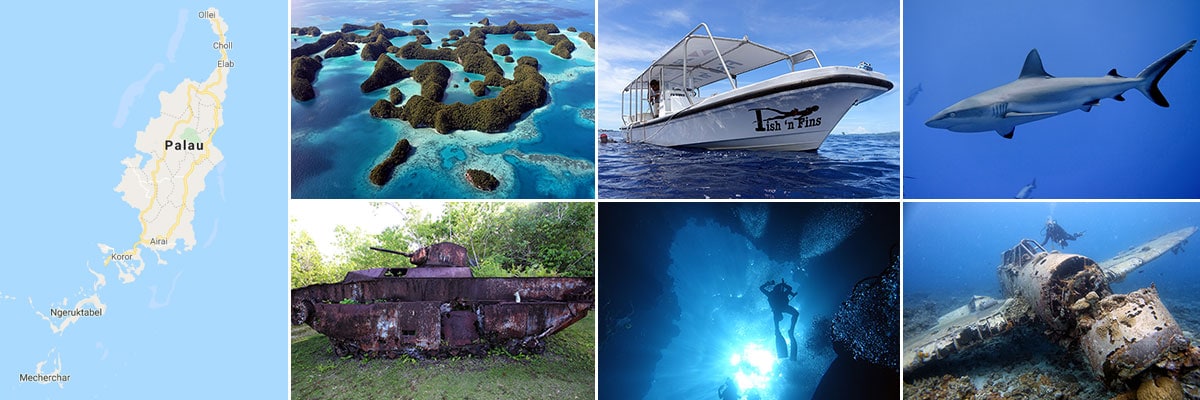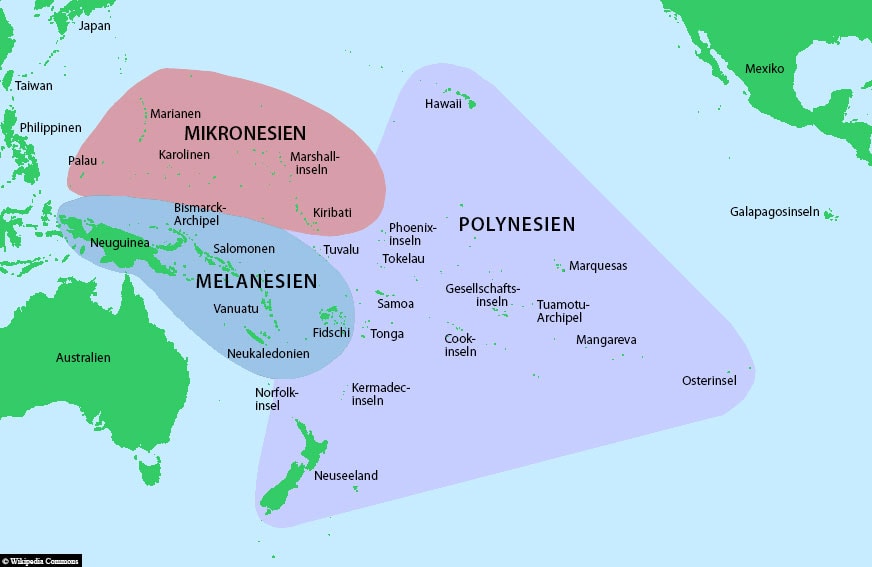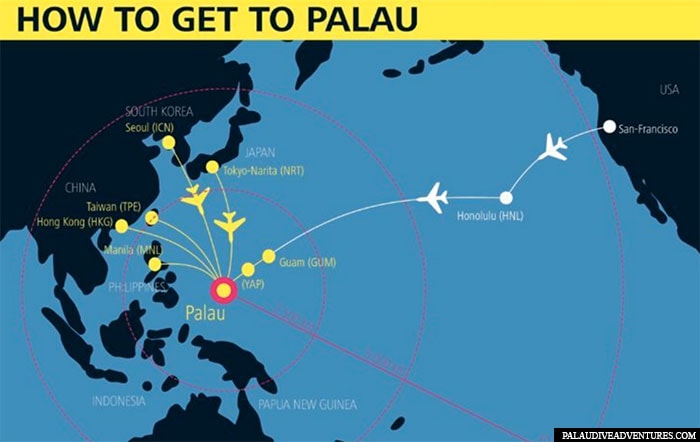The islands of Palau in Micronesia are one of the most beautiful diving areas in the world. The dreamlike images of the UNESCO World Heritage Rock Islands have certainly been seen by many on the Internet or in reports on television. We spent a total of 12 days on Palau and have summarized in this post everything important (arrival, entry requirements, climate, hotels, attractions, diving) for a holiday in Palau for your own travel planning.

Table of contents
Where is Palau located?
Palau is located in the western Pacific Ocean and consists of hundreds of small islands. On the world map, Palau is located about 800 kilometers east of the Philippines and 3,200 kilometers south of Japan. The archipelagos of the Palau Islands consist of a total of 356 islands, the largest of which is Babeldaob with 396 km2. Only eleven of the islands are inhabited. As a destination, Palau is still relatively unknown to Europeans – 75 percent of tourists come mainly from Japan, Korea and Taiwan. The remaining holidaymakers come from the USA, Australia, the Philippines and only a small part from Europe.
The island state of Palau is part of the island region of Micronesia. The term Micronesia stands for several independent countries in the Pacific, which form an “island sea” of over 2,000 tropical islands and atolls over 4,000 kilometers. The nine archipelagos of Micronesia, all of which have their own language, culture and history, consist of: Guam, Palau, the Northern Mariana Islands, the Marshall Islands and Kiribati and the Carolinian archipelago consisting of Yap, Chuuk, Pohnpei and Kosrae.
Things to know for a holiday in Palau
What is very interesting is that Palau was German territory for 15 years. In 1899, Spain sold the archipelago to the German Reich at a bargain price, and the South Seas colony became part of the then imperial protected area “German-New Guinea”. Until the First World War, Germany, among other things, dismantled phosphate here. In 1914, Palau was left to the Japanese during World War I, until they were expelled by the United States in World War II after heavy fighting. Only since 1994 has Palau been independent and thus one of the youngest states in the world. In the absence of its own local currency, the US dollar is used in Palau. The official languages are Palau and English, but some other Micronese languages are also spoken.
The only real city on Palau and at the same time the economic center is the former capital Koror. It is also home to 2/3 of the inhabitants. In 2006, the capital was relocated to Melekeok on the main island of Babeldaob. Palau has only about 20,000 inhabitants,but funnily enough, 16 states.
20 facts about Palau
– Palau is an island nation in the Pacific Ocean and is part of the Pacific island region of Micronesia
– Palau consists of over 350 islands
– Palau has just over 20,000 inhabitants
– Palau is a presidential republic and divided into 16 administrative units
– The largest island is called Babeldaop, the largest city is called Koror
– Melekeok has been the new capital of Palau since 2006, before it was Koror
The next major states are the Philippines and Indonesia
– The island of Koror is home to the largest number of inhabitants
– Palau has two official languages: “Palauisch” (or “Belauisch”) and English
– The climate in Palau is tropical and the average annual temperature is 27 °C
– Palau has only one airport, The Palau International Airport
– Palau is one of the best diving destinations in the world
– The underwater world of the region counts over 1500 species of fish and 700 species of coral and anemone
– Most hotels are in the former capital Koror
– No special vaccinations are required when entering Germany
– The local currency is US Dollar (USD)
– Palau has only been independent since 1 October 1994
– There is no German embassy on Palau. The next located are in Manila, the capital of the Philippines
– 75 percent of the tourists on Palau come from the USA, Japan, South Korea, Taiwan and the Philippines
– The Chelbacheb Islands, also known as the Rock Islands of Palau, are a UNESCO World Heritage Site
Flights from Germany to Palau
Getting to Palau, just over 12,000 kilometres away, from Germany is not so easy. There are no direct flights from Europe to Palau. There are possible connections with a stopover via Seoul (Korea), Taipei (Taiwan), Hong Kong (China), Tokyo (Japan), Manila (Philippines) or via Guam from the west coast of the USA. From our point of view, China Airlines, which offers direct flights frankfurt to Taipei (daily) and Taipei – Palau (2 x weekly), has the best flight connection and the best offer from Germany. The pure flight time is about 17 hours (13 hours from Frankfurt to Taipei + 4 hours from Taipei to Koror). With the stopover you are about 21 hours on the wayfrom Germany until you arrive in the island paradise Palau. Prices for a flight from Germany to Palau are usually around 800 to 1,000 euros. Very good offers from 500 to 800 euros are also available, but you rarely find.
The best time to visit Palau
The best time to visit Palau is from February to April. It rains the least here. In general, however, the tropical island world can be visited all year round. Temperatures are usually between 24 and 30 degrees.
Entry and visa requirements for Palau
Palau has only one international airport, the airport in Koror (Roman Tmetuchl International Airport). As a German citizen, you have been traveling visa-free (at no additional cost) since 2015 and are allowed to stay in the country for up to 30 days (as of 22 April 2017). The passport must be valid for at least 6 months beyond the stay. However, it is important to show your return ticket when entering the country. Up-to-date travel information and security advice can be found on the website of the Foreign Office. Every tourist must pay an exit tax of 20 US dollars and a so-called “green fee” of 30 US dollars in cash upon departure.
» More on this: Entry and exit (visa) at Koror Airport
The hotels in Palau
We found it not so easy to find a suitable and beautiful hotel with beach access in Palau. From many other islands Bora Bora, Tahiti, Moorea, Fiji or of course Hawaii we were used to a quite large selection of hotels in all price ranges. On Palau, however, there are virtually no western hotel chains and there are no large number of good hotels, or most are located in the city and therefore have no beach access. Ultimately, our decision was made at Palau Royal Resort, part of the Japanese international hotel chain Nikko, which opened in June 2005.
The Palau Royal Resort (PRR) is one of the best hotelson the island with the Palau Pacific Resort (PPR), has its own private white sandy beach with an attached lagoon and also a beautiful swimming pool. We liked the stay in the hotel very much and we can therefore recommend it without any restrictions.
» Read more: Hotel Palau Royal Resort in Koror
The UNESCO World Heritage Site of Rock Islands
Palau is best known for the fantastic world of the so-called Rock Islands. The Rock Islands are tropically overgrown mini-islands that protrude from the sea like mushrooms. A boat trip through this island world or a sightseeing flight over the Seventy Islands archipelago, together with the turquoise-green sea, reveal breathtaking sights. In 2012, the 100-hectare Rock Islands Southern Lagoon in Palau, with its 445 uninhabited limestone islands of volcanic origin, was declared a UNESCO World Heritage Site and World Heritage Site. The lagoon is home to a complex reef system with over 385 corals and a large number of different creatures – under and above water.
» More: The Rock Islands in Palau & Infos about Lake Jellyfish
» Read more: A round trip over the Rock Islands & Seventy Islands
Diving in Palau
The islands of Palau are often described as one of the best and most varied diving destinations in the world. As early as 2009, Palau declared its territorial waters to be the world’s first shark sanctuary. More than 1,500 different fish species and 700 coral and anemone species make every dive a spectacular journey of discovery into the underwater world. In addition to all kinds of reef and current dives, there are the well-known Blue Holes and also many wrecks from the Second World War. In total we did 17 dives in Palau and saw diving spots like the Blue Corner, the Blue Holes, the German Channel, the Ulong Channel or the Big Drop Off. The Blue Corner is certainly an exceptional diving spot, which is rightly considered one of the best dive sites in the world!
» Read more: Diving in the island paradise of Micronesia
» More: Fish ‘n Fins Diving School in Palau
» Read more: Blue Corner – Diving with Sharks
» Read more: German Channel – Diving at the Manta Hotspot
» Read more: Jake Seaplane – Diving at the plane wreckage
» Read more: Peleliu – Diving on Palau Island
What to see in Palau
Palau is best known for its diverse underwater life. But also on land there are some interesting sightsthat you can see. Most of these are located on the main island of Babeldaob, which can be explored relatively easily with a rental car (approx. $50 per day). The entire island is covered by a well-developed ring road, where you can find the following sights: the National Capitol in Melekeok, the Stone Monoliths in Badrulchau and the Ngardmau Waterfall.
It is also recommended to make a land tour to the historical theatres of war and remnants of world war ii between the Japanese and the USA on Peleliu. Here you will find old Japanese and American tanks, the overgrown ruins of the former Japanese headquarters, Japanese anti-aircraft guns hidden in the rock and a small World War II museum.
» Read more: A tour of the island by car via Babeldaob
» More: A tour to the island’s theatres of war (Palau)
All travelogues from Palau
The islands of Palau, together with Blue Corner and the German Channel, are among the most beautiful and interesting dive sites in the world. And the fantastic pictures of the UNESCO World Natural Heritage Rock Islands have certainly been seen by many on the Internet or in reports on TV. We spent a total of 12 days on Palau and got to know the island paradise both above and under water. » Palau – Travel Guide, Diving & Things to Do
» Palau – Travel Guide, Diving & Things to Do» Palau – Entry & Exit (Visa) at Koror Airport
» Koror – The Palau Royal Resort on Malakal Island
» Diving with the diving school Fish ‘n Fins
» The Rock Islands in Palau & Infos about Jellyfish Lake
» The Blue Corner – Diving with Sharks & Napoleon Lip Fish
» The German Channel – Diving at the Manta Hotspot
» Jake Seaplane – Diving at the Plane Wreck
» Palau – Diving in the island paradise of Micronesia
» Peleliu – Diving on Palau Island
» Peleliu – Historical tour of the old battlefields in World War II
» Palau – Our Self-Guided Day Tour of Babeldaob Island
» Palau – Scenic Flight over the Rock Islands & Seventy Islands



